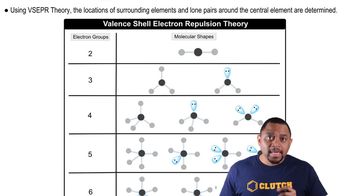The figure that follows contains ball-and-stick drawings of three possible shapes of an AF4 molecule. (a) For each shape, give the electron-domain geometry on which the molecular geometry is based. iii.
Ch.9 - Molecular Geometry and Bonding Theories
Chapter 9, Problem 29a
Give the approximate values for the indicated bond angles in the following molecules: (a)
 Verified step by step guidance
Verified step by step guidance1
Identify the central atom in the molecule.
Determine the electron domain geometry around the central atom using the VSEPR theory, which considers both bonding and non-bonding electron pairs.
Count the number of bonding pairs and lone pairs around the central atom to predict the molecular geometry.
Use the molecular geometry to estimate the bond angles. For example, in a tetrahedral geometry, the bond angles are approximately 109.5 degrees.
Consider any deviations from ideal bond angles due to factors such as lone pairs or double bonds, which can affect the angles.

Verified Solution
Video duration:
2mWas this helpful?
Key Concepts
Here are the essential concepts you must grasp in order to answer the question correctly.
Bond Angles
Bond angles are the angles formed between two adjacent bonds at a central atom in a molecule. They are crucial for understanding molecular geometry and are influenced by the arrangement of electron pairs around the central atom, which can be affected by factors such as lone pairs and the type of bonds (single, double, or triple).
Recommended video:
Guided course

Bond Angles
VSEPR Theory
Valence Shell Electron Pair Repulsion (VSEPR) theory is a model used to predict the geometry of individual molecules based on the repulsion between electron pairs in the valence shell of the central atom. According to VSEPR, electron pairs will arrange themselves to minimize repulsion, leading to specific bond angles characteristic of different molecular shapes.
Recommended video:
Guided course

Molecular Shapes and VSEPR
Molecular Geometry
Molecular geometry refers to the three-dimensional arrangement of atoms within a molecule. It is determined by the number of bonding pairs and lone pairs of electrons around the central atom, which influences the bond angles. Common geometries include linear, trigonal planar, tetrahedral, and octahedral, each with specific bond angle values.
Recommended video:
Guided course

Molecular Geometry with Two Electron Groups
Related Practice
Textbook Question
478
views
Textbook Question
The figure that follows contains ball-and-stick drawings of three possible shapes of an AF4 molecule. (a) For each shape, give the electron-domain geometry on which the molecular geometry is based. ii.
364
views
Textbook Question
The figure that follows contains ball-and-stick drawings of three possible shapes of an AF4 molecule. (c) Which of the following elements will lead to an AF4 molecule with the shape in (iii): Be, C, S, Se, Si, Xe? i.
ii.
iii.
852
views
Textbook Question
Give the approximate values for the indicated bond angles in the following molecules: (c)
489
views
Textbook Question
Give the approximate values for the indicated bond angles in the following molecules: (a)
426
views
Textbook Question
Give the approximate values for the indicated bond angles in the following molecules: (d)
1408
views
